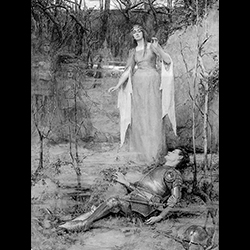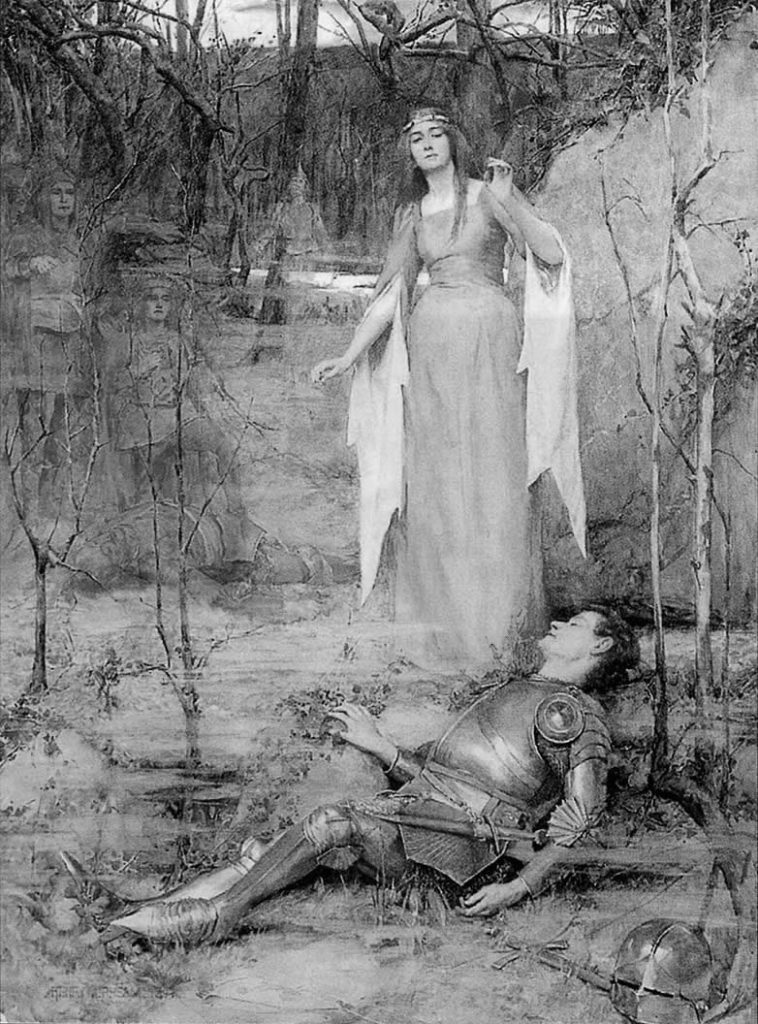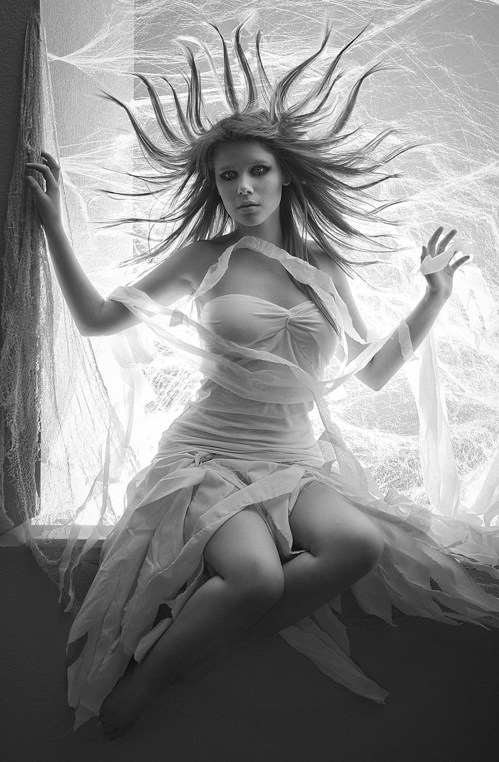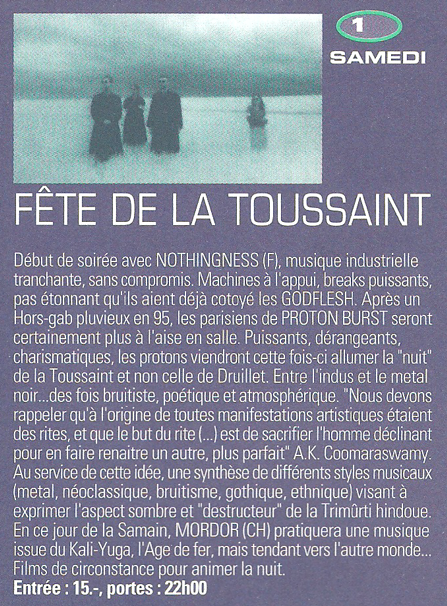
“They scatter the battalions of the foe,
They ravage every land they attack,
Splendidly they march to combat,
A swift, distinguished, avenging host!”
– A stanza of the poem The Host of Faery in Selections from Ancient Irish Poetry, Kuno Meyer
1. Of the 1997 live act, “Les Armées de Sauron” and J.R.R. Tolkien
Historic video of one of the very few Mordor live acts, celebrated on 1st November 1997 at La Case à Chocs, Neuchâtel, in Switzerland – a place located not so far from the Iron Age Celtic archaeological site of La Tène – to remember Samain, the Old Irish feast that marked the end of the light half part of the year and the beginning of the dark one. The intent behind the live act was also to remind that “all artistic operations were originally rites, and that the purpose of the rite […] is to sacrifice the old and to bring into being a new and more perfect man.”[1] Despite poor visual quality and audio recorded from the audience place by camera, this music video is still an unique document, featuring the track “Les Armées de Sauron”. The song, composed between 1992 and 1993, first appeared on the picture 7” released by the Dutch label Shivadarshana Records in 1994, and was later slightly reworked for some live acts in 1997 and 2008.
The track merging initially blackened doom metal with symphonic/industrial music influences was obviously based on J.R.R. Tolkien’s fictional world, however interpreted in a symbolic sense. Just like an animal such as the snake can be symbolically ambivalent, we were considering at the same time the negative sense given by Tolkien to Melkor (Morgoth), Sauron… as agents of evil and subversion, and a positive sense rooted in the Left-Hand path in order to achieve the total freedom – at least a certain degree of it – enjoyed by the Tantric adept, although not present in the original Tolkien’s stories. “Les Armées de Sauron” also reflected between the lines traditional metaphysical perspectives on war, especially about the “inner war” against the internal foes related to the necessary transformation of the “lower self” and the duty of overcoming one’s own limited nature. It was finally the opportunity to pay tribute to Tolkien, the famous epic fantasy writer and philologist who invented coherent constructed languages to serve his literary work, and to whom we owe the name of our band, Mordor, which means “Black Land” or “Land of Shadows”.
Besides Catholicism whose influence was preponderant, Tolkien was inspired, inter alia, by European mythologies and folklore, such as early Germanic and probably Celtic literature – despite his denying –, the Finnish national epic Kalevala etc. to create an oeuvre with the intention in his words “to restore to the English an epic tradition and present them with a mythology of their own”. It has became a classic, used by many metal bands albeit with an emphasis on the evil forces appearing in Tolkien’s corpus. Here are some lines of Mythopoeia, a revealing poem written by him in circa 1931 following a discussion on the value of mȳthos with C.S. Lewis and another member of the Inklings literary group, and defending the viewpoint that myths are not merely worthless lies but contain spiritual and foundational truths:
“Blessed are the legend-makers with their rhyme
Of things not found within recorded time.
It is not they that have forgot the Night,
Or bid us flee to organized delight,
In lotus-isles of economic bliss
Forswearing souls to gain a Circe-kiss
(And counterfeit at that, machine-produced,
Bogus seduction of the twice-seduced).
[…]
They have seen Death and ultimate defeat,
And yet they would not in despair retreat,
But oft to victory have tuned the lyre
And kindled hearts with legendary fire,
Illuminating Now and dark Hath-been
With light of suns as yet by no man seen.
[…]
I will not walk with your progressive apes,
Erect and sapient. Before them gapes
The dark abyss to which their progress tends
If by God’s mercy progress ever ends,
And does not ceaselessly revolve the same
Unfruitful course with changing of a name.”

2. Of the Old Irish feast Samain
Samain[2] was one of the four Gaelic seasonal festivals of the year, held conventionally on 1st November in mediaeval Ireland, but the preceding night was perhaps the most important period of the feast, due to the fact that the Celtic day started and ended at sunset. In Bellum Gallicum, Caesar asserts that the Gauls “determine all amounts of time not by the number of days but of nights; they keep birthdays and the beginnings of months and years in such an order that the day follows the night”, for the reason that “they are all descended from the god Dīs [Pater, i.e. Plūtō]”, probably a Celtic deity akin to the Roman chthonic one. However, the real date of celebration and the length of the feast, perhaps of three, seven whole days or even more, may have been subject to local variations according to the sources. Samain was likely a pan-Celtic festival as the Gaulish month name samon[ios] and the entry “the three-nights of Samonios [begin] today” are attested on the Coligny calendar, even though interpretations differ on the matter of the seasonal placements of the months.
There is not a lot of detailed information available about the specific rites related to Samain, but it seems that it was a great mandatory assembly associated with the end of summer and the harvest/ grazing season, the onset of winter, tax-gathering including a tribute for the Fomóiri (a mythical dark, nether people), contests, judicial and legislative process, sacral sovereignty, with probably ritual banquets, divination, bonfires, extinguishing of old fires and ignition of new ones as exemplified by the sacred Tlachtgha[3] fire, offerings, sacrifices, and so forth. Françoise Le Roux and Christian-J. Guyonvarc’h in Les Fêtes Celtiques, in accordance with Georges Dumézil’s tripartite ideology hypothesis, consider Samain a “total and trifunctional feast”, when the three main social classes, namely in broad outline priests (druids, subdivided into various categories of specialists including jurists, bards, physicians…), warriors, and producers (craftsmen, herdsmen, farmers…) are involved as well as otherworldly beings endowed with féth fíada, a magic mist, veil or “gift of invisibility” rendering their presence normally invisible to human eyesight. For the mediaevalist Philippe Walter in Christian Mythology, Revelations of Pagan Origin:
“The major dates of the mythical calendar allow for intense exchanges with the Otherworld, as Samhain admirably demonstrates. All the myths connected to the feasts whose cycles are opened by Samhain recount to one degree or another the communication between the Otherworld and the human world. Thus, the major dates of the mythological calendar – most particularly Samhain – led to the emergence of the Faery into the world of daily life. If even today there is a trivial association of All Saints’ Day with cemeteries and commemorating the dead, it is because in our obscure mythical memory bank the date of November 1 remains connected to the passage of souls and ghosts between the two worlds.”

fine painting by Henry Meynell Rheam, 1897-1901,
public domain.
3. Of Samain and the Middle Irish tale “The Violent Death of Muirchertach son of Erc”
For Samain was seen as a liminal time when the border that separates the ordinary reality from the síd (Old Irish name of one of the Otherworlds, literally “fairy mound”, populated by supernatural beings, the áes síde) is temporarily at its thinnest, allowing the contact between the two worlds and their inhabitants, “for the fairy-mounds (síde) of Ireland were always open about Samain; for on Samain nothing could ever be hidden in the fairy-mounds” (Macgnímartha Finn). F. Le Roux and Chr.-J. Guyonvarc’h write in Les Druides, our translation: “The usually cold, dark November weather, the northwesterly wind coming from the dead, the long nights favourable to meetings and banquets do the rest.” Philippe Jouët considers that the first element of *samoni- is etymologically cognate with Ancient Greek Háidēs[4] and consequently, that Samain was also a feast of gathering with the Manes. If it was likely a favourable moment to strengthen social cohesion and links with deities to ensure the maintenance of the world from chaos, to honour the ancestors and propitiate inorganic beings to guarantee that people will survive the winter, there was, however, the substantial risk of encountering potentially malevolent spirits, occult dangers and serious trials. Thus in the tenth to twelfth century late Middle Irish account Aided Muirchertach Meic Erca “The Violent Death of Muirchertach son of Erc”, the king Muirchertach while hunting meets Sín (“Storm, Tempest”), an otherworldly fair-headed maiden of exquisite beauty, who seduces him and will be finally the cause of his death at a time close to Samain, “the sigh of a winter-night”[5]:
King Muirchertach asked:
“Tell me your name, O damsel,
You most beloved, star-bright lady,
You who parts me from my family,
Don’t hide it from me by withholding it.
Sín answered:
Sigh, Roaring, Storm without reproach
Rough-Wind and Winter-Night,
Tears, Lament, the silent Wail
And the sound of the weeping cow.
[…]
And Sín said:
I am Rough-Wind,
A daughter of fair nobles:
Winter-Night is my name,
I am everywhere at the same time.
Sigh and Wind
Winter-Night so,
I speak the truth,
That your end is coming soon.
If you come thither,
To the door of your house,
Death will come to your lips.
In these words, you will find knowledge.”
Based on the English translation by Diane Pestano.

Original coloured picture changed to greyscale. License CC BY-SA 3.0
King Muirchertach was faced in particular with several spells, a northwesterly snowstorm, a host of demons and finally died because of the magic caused by Sín for the sake of vengeance in a weird way: he first drowned himself in the cask of wine where he found refuge for fear of the ghostly fire kindled by her, the house fell on his head[6] and eventually was partially burned. Despite the evident Christianization of the original story, several elements like the fairy lady Sín and the crucial role played by magic show its pagan roots, dating back perhaps to Proto-Indo-European times, with the threefold death theme. An interpretation of the tale by Ph. Jouët proposes among other things that the narrative deals with an “underlying thanatology” and the most sinister side of Samain – degenerating into a chaotic “night of confusion” –, when the gorgeous fairy, sovereignty test of kingship, no longer renovates the realm but destroys it, and that wine, or other alcoholic beverages like mead and beer, does not grant a relative immortality as during the ritual banquet, but death. In the end, the king, worn out by the exercise of power, was unable to cross neither primal elements, such as fire and water, nor defeat winter’s weapons, and even less to resist the mortal charms – in both senses of the word – of a mighty, griefless woman of the síd, telling her unwisely: “I will give you power over me, O damsel”. We know the rest of the story…
4. Concluding note on Samain
In summary, it appears that Samain was a privileged turning point of the year marked by important religious and political events. The period of the feast was a very particular moment outside of ordinary time, with numerous potentialities related to the New Year according to the cyclical view, and the temporary near abolition of the barrier between the human world and the síd; the gateways between the worlds, usually closed, are wide open at this juncture. However, several tragic, odd deaths as that of King Muirchertach occurring around Samain recall that the contact with the unseen world and its various beings is never innocuous, for better or worse. The spirit world and men may have conflictual relations too, and not all otherworldly races and dead are benevolent to the living. The view that winter predates summer as night precedes day, or that the Gauls descended from a Celtic Dīs Pater, derives probably from a metaphysical conception where Being proceeds from Non-being.[7]
As a final point to our notes, we would like to cite Ananda K. Coomaraswamy’s relevant remark: “It is only when we realize that the arts and philosophies of our remote ancestors were ʻfully developed,ʼ and that we are dealing with the relics of an ancient wisdom, as valid now as it ever was, that the thought of the earliest thinkers will become intelligible to us.”[8] Instead of the arrogant attitude typical of the contemporary “civilised” man obsessed by technical prowess, prisoner of a very narrow perceived reality, and disdainful of the so-called “prelogical mind”, we believe that the approach proposed by Coomaraswamy should be the necessary premise to try to understand something of the ancient traditions and, for those now vanished, what may remain of them in folklore. As he sums it up neatly in a few words: “the myth is always true (or else no true myth), while the ʻfactsʼ are only true eventfully.”[9] We also think that perception with its subtle possibilities usually ignored should play an essential role to better realize the value of the lore transmitted in one way or another by our distant forebears. As do sorcerers mentioned by Carlos Castaneda in The Power of Silence, we should consult the past in order to obtain a practical point of reference to examine intent, the power in action behind archaic stories.
5. Credits
“Les Armées de Sauron” is dedicated to John Ronald Reuel Tolkien.
Original Mordor line-up had been expanded for this Samain live act to include four additional members, with a real drummer instead of the drum machine frequently used in our recordings, and some visuals.
Mordor were at the time of this event:
Scorh Anyroth – voice, guitar, machines
Dam Gomhory – bass, voice, machines
Flore de la Mandragore – female voice
S3th – guitar & percussion
Farkás – drums & percussion
H.G. – visuals
Music and words by Scorh, 1992-1993, 1997; video footage was shot in 1997 by ThR and Kurial; music video edited by N., 2007.

Only Proton Burst and Mordor finally played during that night.
[1] Ananda K. Coomaraswamy, Figure of Speech or Thought?, published in The Door in the Sky, Coomaraswamy on Myth and Meaning, writings selected and with a preface by Rama P. Coomaraswamy. Of course, a “new and more perfect man” should not be understood as the “fixed, enhanced man” of transhumanism, but in a spiritual sense: “So in the Indian Sacrifice, the purpose is to bring forth out of the old a new person, that of the sacrificer’s real Self, and that is compared to the drawing of an arrow from its sheath or a snake from its skin.”, A. K. Coomaraswamy, Sir Gawain and the Green Knight: Indra and Namuci, in Speculum, Vol. 19, No. 1 (Jan., 1944). Sacrifice for Coomaraswamy in the context of a non-dualistic doctrine is not only a commerce between gods and men but may grant a relative immortality, deification, and is the ritual mimesis of a primordial divine act: “We must do what the gods did erst” (Śatapatha Brāhmaṇa).
[2] Old Irish name of the feast – Irish Samhain cognate with Scottish Gaelic Samhuinn, Manx Gaelic Sauin; the name of the month of November in Irish is mí na Samhna, Samhna being the genitive singular of Samhain –, whose significance is much debated: an etymology perhaps of folk origin suggests “decline of the summer”, with the first element sam derived from the Proto-Indo-European root *sem-² “summer”, but for several academics such as Françoise Le Roux and Christian-J. Guyonvarc’h, (see Annexe 1 Remarques sur le nom de Samain in Les Fêtes Celtiques), following Celtic scholar Whitley Stokes, the initial notion behind the name Samain was that of “gathering, assembly”. The linguist Julius Pokorny compares Old Irish samain (Proto-Celtic *samoni-) to Gothic samana “together, in common” and Old High German saman “together”, both derived like Old Norse saman, Sanskrit sam-, Avestan ha-, ham- (all words roughly meaning “together”) etc. ultimately from the PIE root *sem-¹ “one, together with”. The sense of Samain would be close to Skt. sámanaṃ “assembly, concourse, festival”, an annual festival gathering of Vedic people, except that this one dealt primarily more with recreation than purely religious purposes from what we know about it. One alternate Middle Irish name of the feast was féil Moingfinne “Mongfind’s festival” after the name of a fair/white-headed goddess or witch/banshee worshipped on Samain’s night according to Aidid Crimthaind Meic Fhidaig.
[3] Tlachtgha, known today as The Hill of Ward, was a site of prominent festivals with four broad concentric earthworks, named according to some ancient texts after a mythical and powerful red-haired druidess, daughter of a renowned blind druid having perhaps solar overtones. “Tradition has it that the ancient Celts assembled on Tlachtga on October 31 and built a sacred fire on which sacrifices, perhaps even human, were offered to thank their pagan gods for a successful harvest. On that night, all fires in Ireland are reputed to have been extinguished, and torches lit from the Tlachtga fire were carried to seven other nearby hills to illuminate the surrounding countryside.” Quotation from Erin Mullally, Samhain Revival, Looking for the roots of Halloween in Ireland’s Boyne Valley, Archaeology Magazine Nov./Dec. 2016, a publication from the Archaeological Institute of America. The Tlachtgha fire is mentioned in Foras Feasa ar Éireann by Geoffrey Keating: “it was there the Fire of Tlachtgha was instituted, at which it was their custom to assemble and bring together the druids of Ireland on the eve of Samhain to offer sacrifice to all the gods.”
[4] In Dictionnaire de la Mythologie et de la Religion Celtiques, following the Indologist Paul Thieme who explained the name of the Greek god and Underworld by Proto-Indo-European *sm̩-vid- “gathering (of the dead)”, *sm̩ being a zero-grade form of the PIE numeral root *sem-¹ (“one, together”), cf. our note [1]. Xavier Delamarre gives for Thieme’s explanation of *sm̩-vid-: “(the place of) gatherings (with ancestors)”, in Dictionnaire de la Langue Gauloise, une approche linguistique du vieux-celtique continental. The original meaning of Proto-Celtic *samoni- would be “assembly of the living and the dead” according to Ranko Matasović, Etymological Dictionary of Proto-Celtic.
[5] The text in the English translation Aided Muirchertach Mac Erca – Full Version provided by Diane Pestano, based on that partial of by Whitley Stokes in Revue Celtique No. 23, indicates: “The seventh night she [Sín] was at her magic, on the eve of Wednesday after Samain precisely”, while the French translation by Christian-J. Guyonvarc’h says about the date, our translation: “it was the seventh night she was at her magic. It was precisely Tuesday after Samain”, in La mort de Muirchertach, fils d’Erc. Texte irlandais du très haut Moyen Âge : la femme, le saint et le roi, published in Annales. Économies, Sociétés, Civilisations. 38ᵉ année, N. 5, 1983. The tale is heterogeneous, using pagan themes reinterpreted according to Christian views. The figure of Sín with her perfect supernatural beauty and her magical means of action is clearly a reminiscence of a banshee, originally a maiden of the síd, messenger able to bring a mortal that she chose in the Otherworld. Furthermore, she is explicitly described as a “woman of the síd” in one verse. In the story, Sín personifies also the old paganism which is vanquished by Christianity – she dies of remorse after repenting – and carnal temptation. There are some partial similarities between Irish war-goddesses, banshees and the Norse valkyrjur, especially those who possess the shapes of swans (álptarhamir). Notice that the sovereignty was perceived in Ireland as a goddess or female being: “King of Tara, I am the Sovranty”, says the hag who is guarding a well in Echtra Mac Echach Muigmedóin, revealing herself as a beautiful maiden when she was kissed.
[6] Detail found in the French translation of the text by Christian-J. Guyonvarc’h, op. cit. It is missing in D. Pestano’s English translation in which it is the fire that fell on the king’s head, but she mentions at the end the threefold death theme, to which a poem refers. There are different types of the threefold death; in one, the full tripartite structure should include death caused by a weapon like sword or spear.
[7] Cf. Claude Sterckx, La Mythologie du Monde Celte.
[8] In On the Loathly Bride, published in Speculum, Vol. 20, No. 4. (Oct. 1945).
[9] In Literary Symbolism, from The Door in the Sky, op. cit. Actual myths of suprahuman origin – directly or indirectly – are not “poetic invention” or literary fantasy, which constitute a shaping of the mythical material, but the deepest sapience put into words that men have, the proper language of metaphysics. For Coomaraswamy, they are of timeless and placeless validity. Likewise, symbols have not a purely decorative role, but may be metaphysically intelligible and possess power.
